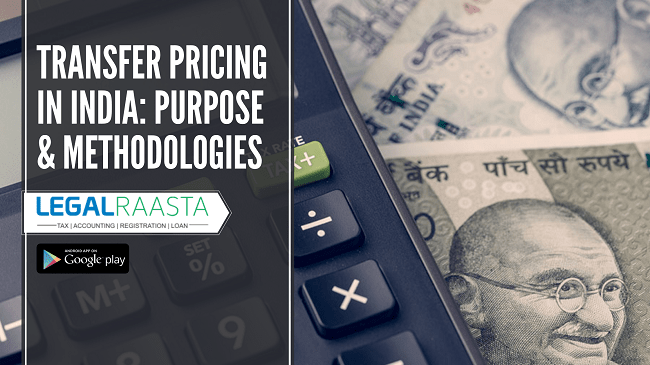Transfer Pricing in India: Purpose & Methodologies
With globalization, there is a significant rise in the number of multinational companies. The transfer pricing is part of
accounting and bookkeeping.
What is Transfer Pricing?
Transfer pricing is an accounting practice that represents the price that the company charges for one division for goods and services provided. Not just tax officials, but also economists,
NGOs, business people, and policymakers who wake up to the call have been involved in the transfer of pricing.
Transfer pricing is used for the establishment of prices for the goods and services exchanged between subsidiary companies that are part of the same enterprise. Transfer pricing may lead to tax reductions for companies, but their arguments could be contested by the tax authorities.
The price paid by a subsidiary to its holding company may be subjective and dictated, and that arrangement may result in tax liabilities being avoided or diminished. Provision of transfer of pricing comes under the income tax act that can be used for the uncontrolled price. Transfer Pricing is nothing but the value associated with the transfer of similar parties of goods or services.
How does Transfer Pricing work?
Transfer pricing is a method of accounting and taxation that encourages transactions to be priced individually within companies and within subsidiaries operating under common management or ownership. The practice of transfer pricing extends to cross border transactions as well as domestic ones.
A transfer pricing is used for services rendered to determine the cost to charge another division or subsidiary. Transfer rates are usually priced depending on the prevailing selling price for the product or service. Transfer pricing can be applied for research, patent, or royalties. Multinational companies are legally allowed to use the transfer of pricing for the allocation of the earnings of their parent organization to their subsidiary entities.
However, by modifying their corporate revenue, businesses may sometimes also use (or misuse) this practice, thus reducing their total taxes. The system of transfer pricing is a means for businesses to move tax obligations to low-cost tax jurisdictions.
Transfer Pricing and IRS
The
IRS notes that the transfer pricing should be the same between intercompany purchases that would otherwise have existed if the group had made the deal outside the company with a client or client. Under section 482, the rates paid by one affiliate to another in any inter-company transaction include the sale of products, services, or intangibles associated with the result that would have been realized if, under the same conditions, unregulated taxpayers had participated in the same transaction. The financial reporting of transfer pricing thus has stringent criteria and is closely supervised by the tax authorities. Extensive reporting by auditors and regulators is also needed. If the transfer value is inappropriate in the financial statements needs to be restarted and penalties would be applicable. There is, however, much controversy and uncertainty surrounding how to pay for transfer pricing between divisions and which division can bear the brunt of the tax burden.
Transfer Pricing Method
There are several methods that tax administrations can use to determine the transfer pricing for transactions between associated companies. Below are the transfer of pricing methods according to the Organization for Economic Co-operation and Development (OECD).
Comparable Uncontrolled Price Method:
This method is grouped by OECD It compares the price of the goods or services and the terms of the transaction under control (between similar entities) with those of the transaction under control (between unrelated entities). This method requires comparable data from a commercial database. If the two transactions end at differing rates, this means that the concept of arms-length cannot be applied under the economic and financial circumstances of the relevant undertakings. If the circumstances are the same, they occur at a similar time and take place at the same point of the manufacturing or delivery process, all transactions should be seen as equal.
Resale Price Method:
The resale price method is the resale price method, a conventional purchase method for evaluating transfer pricing. This strategy begins by looking at the resale price of a product acquired by a similar business and then sold to an independent group. The resale price is considered the price of the deal where the commodity is resold to an individual entity. The resale price is the transaction where the item was sold to an independent enterprise. This method requires the resale price margin to be identified Which is the amount of money needed to cover the costs of the related sale and operational expenses by the party reselling the items.
Cost Plus Method:
The cost-plus approach is a standard method of transaction that analyses a managed transaction between the seller and the customer involved with it. Usually when Associated Parties transact the semi-finished goods then This method is used. The cost of suppliers is added up to markup for the product or service so that suppliers make an adequate profit that tackles into account the function they performed and the current conditions of the market. The aggregate price is the transaction's arm's length price.
Transactional Net Margin Method (TNMM):
TNMM is one of the two types of transactional benefit outlined by the OECD in order to assess transfer pricing. In this type of method, the profits from controlled transactions are assessed. The TNMM includes the measurement of net benefit against an "appropriate base" arising from a managed transaction, such as revenue or properties. The OECD notes that taxpayers should use the same net benefit indicator that they would use in equivalent unregulated purchases, in order to be consistent. The taxpayers need to carry out functional analysis of the transaction to assess their compatibility.
Transactional Profit Split Method:
This method focuses on highlighting how profits and losses would be divided within enterprises in comparable transactions. It will remove any influence from special conditions made or imposed in controlled transactions. It begins by deciding the income that is to be divided from the regulated transactions. The proceeds are then divided between the related companies according to how in a similar unregulated trade they would have been split between independent businesses. Below are two main approaches that can be considered for splitting profits.
Contribution Analysis:
The cumulative earnings are split according to the relative valuation of the functions conducted within the managed transaction by each of the associated organizations (considering assets used and risks assumed).
Residual Analysis:
The combined earnings are separated into two steps. Next, for their duties and contribution to the managed exchange, each individual is allotted arm's length compensation. Second, depending on consideration of the facts and conditions of the deal, any residual benefit or loss following the first stage is split.
Transaction That Comes Under Transfer Pricing
1) Management Fees
2) Sale of accomplished goods
3) Purchases of fixed assets
4) Sale or purchase of machinery
5) Purchases of raw material
6) Selling or purchasing intangibles
7) Paid/received return of expenses
8) Support Services
9) Technical Services fees
10) Loan paid/ received
11) Corporate guarantee fees
12) Software development fees
13) IT Services
14) Royalty Fees
15) Any other transaction that has an impact on profit, income, losses, or assets of the enterprise
Benefits Of Transfer Pricing
- Companies can reduce the duly cost using transfer pricing. It requires business organizations to export goods paying minimal transfer rates to high-tariff nations. Consequently, the duty base related to transactions will become low.
- Business Entities can successfully earn higher profit margins by using the method of transfer pricing; companies reduce income tax in countries that have high charges comparatively by overpricing goods, they transfer them to the countries where they can have the leverage of lower tax rates.
Risk of Transfer Pricing
With benefits come a certain amount of risk. Transfer pricing has a certain type of risk factor that is given below.
- One of the key issues to worry about is conflict among managers of the organizational division about price policies.
- Different charges are also correlated with transfer pricing. It takes considerable time and manpower to design a competitive accounting method in line with transfer pricing. That's the reason why it costs more.
- It is a difficult challenge to determine the correct sum when deciding the price strategy for intangible goods such as utilities.
- Since the buyer and seller go through multiple functions, a certain form of danger occurs. There are several threats that really affect this price. Those are among the following,
- Risk regarding collection
- Entrepreneurial risks and market risks
- Currency and financial risks
- Credit risk
- product/technology obsolescence risk
- The transfer pricing mechanism is not only incredibly complex but also time-consuming in the case of major multinationals. In addition to that, there could be unstable actions among the administrators of organizational units leading to disputes over transfer pricing.
- Independent unregulated transactions used for the calculated Arm's Length Price will often not be found and it is virtually difficult to evaluate ALP
A Tax Concern
Transfer pricing is consistently among the top tax issues for multinationals because of the inherent ambiguity in pleasing tax authorities and the possible dollar sums involved. In the coming years, the challenge and volatility associated with transfer-pricing positions are expected to rise. Governments are directing tax authorities to boost transfer-pricing audits under pressure to collect revenue. In its transfer-pricing tools, the IRS has made a significant investment. The Broad Business and International (LB&I) Division unveiled its international practice networks last year to unify and put institutional experience to bear on international regulatory functions. More transfer-pricing analysis tools would be focused by the IRS on medium-sized taxpayers with funds as little as $10 million.
Purpose of Transfer Pricing
The basic purpose of the transfer pricing is:
- For all the branches they have, transfer pricing encourages corporate companies to generate benefits independently. Not only that, but it also helps them to independently assess each plant's output.
- In addition to one center's reported benefit, transfer pricing also encourages corporate companies to distribute the services of the organization, taking into account the overall expense of one center as the resource they have used.
Legal entities that have several branches under a single corporation that are wholly or major share can be owned by the parent corporation. There are several jurisdictions that recognize the traditional influence of business companies whether they share family members on their board of directors' list. Transfer pricing plays an instrumental role to allocate profit to a multinational corporation when it comes to clear tax liability in different countries where they do business.
It effectively allows the price to be fixed between units within an organization. Transfer pricing provides international firms with tax incentives, but regulatory agencies also prefer to use it for tax evasion or not. Companies will promise income on goods and services in various countries that have a lower tax rate by transfer of pricing. International tax laws are governed by the Organization for Economic Cooperation and Development (OECD). When international goods and services are exchanged from one country to another through an interrelated company.
The transaction could allow the company to escape exchange tariffs. Principles of transfer of pricing are used to determine arm’s length price for the transaction that took place between associate entities so that any reduction of tax liability can be mitigated. Under transfer pricing, there are separate principles for the calculation of the "Arm's Length Price'' considering the transaction between independent parties.
Accessing Data for Transfer Pricing Analyses
The alternative that a company chooses to use depends on the individual circumstance. The amount of relevant comparative data available, the level of comparability of unregulated and controlled transactions at issue, and whether a system is suitable for the existence of a given transaction should be taken into account (determined through a functional analysis). The OECD states that it is not necessary to use more than one transfer of pricing method when determining the arm's length price for a particular transaction.
Conclusion
No matter whether it's a small or large-scale company, for many corporations, the transfer of pricing has posed foreign tax concerns. For ensuring that your business is in compliance with the global regulation you can use transfer pricing for cost-cutting. To retain transparency in an enterprise, updating the transfer pricing policy and documents along with the risk and benefits of transfer pricing is important. We at LegalRaasta, provide services like
Accounting & Bookkeeping Services,
Trademark Registration,
Company Registration,
FSSAI License,
and many more. So, contact the expert team of
“LegalRaasta”, for a completely smooth and hassle-free process.










